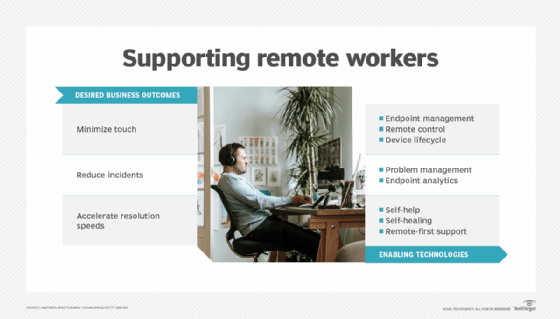
pathdoc - stock.adobe.com
3 hybrid work strategy tips CIOs and IT need now
Moving to a hybrid work model presents a number of challenges for companies. Here's how IT leaders can help overcome obstacles and support success.
Many companies are in the process of creating or refining their hybrid work strategy. CIOs and other IT leaders are critical to ensuring that strategy is a success.
Planning a return to the office is complex: It's not as simple as turning on the lights and bringing employees back to the pre-pandemic office they remember. Business and IT leaders must rethink and improve office spaces to ensure employee safety and support their new hybrid workforce.
Here are three ways IT leaders can bring clarity to reopening plans, enable hybrid work and improve the employee experience.
1. Build alignment across departments
When companies shifted to remote work, IT was in the driver's seat for making the transition happen. They quickly deployed videoconferencing and collaboration technologies, optimized networks and implemented new security policies.
Reopening offices -- especially if those offices are moving to a hybrid model -- is far more complex.
IT is looking to HR to tell them which employees will return to the office and which will remain remote. HR is looking to IT for guidance on hybrid-office technology. And facilities managers are looking to HR and IT to advise on safety protocols, occupancy levels and building technology, such as IoT sensors.
The reality is that these teams must break down their silos and work together to align employee needs, technology requirements and physical building requirements to make the right reopening decisions for their company.
By forming a cross-functional committee, IT leaders can make informed technology decisions that meet employee needs and align to short- and long-term business goals.

2. Develop a hybrid work framework
Many companies will use a hybrid work model, where employees split time between the office and remote work, as a key component of their reopening plans. Most organizations will need to provide guidance for employees.
While hybrid work gives employees greater flexibility, many organizations will need consistent guidelines that specify which employees will work from home and how often will be critical to success. Such guidelines help avoid differing levels of flexibility that may vary by manager.
A structured approach based on dynamic personas, or groupings of employees who share common characteristics, services and requirements, offers a framework for determining who works where and why.
IT can develop dynamic personas by using employee job descriptions, employee interviews, historical IT data and institutional knowledge to paint a clear picture of who, what and where services need to be delivered. This allows IT to provide more personalized support than grouping employees by department.
3. Elevate digital workspace and employee experience leaders
A return to the office presents several challenges to maintaining company culture and a positive employee experience.
First, employees will be spread across remote and office locations. Office-based processes and systems must adapt to include remote workers. For example, IT will need to equip meeting rooms with videoconferencing technology to include remote participants.
Second, strategic leaders are rethinking why and how they use offices as part of their hybrid model development. Rather than using offices as a catchall place of work, many companies will have employees visit the office for specific events, such as team meetings or social gatherings. This will require companies to change their office layouts to include more huddle spaces and fewer individual desk stations.
Additionally, new safety policies and procedures will change employee routines. For example, employees will need to learn how to use new touchless technologies in conference rooms and at time clock stations.
Digital workspace and employee experience leaders will play a critical role in overcoming these obstacles and ensuring their companies deliver positive employee experiences in the office and at home. Gartner predicts that by 2024, 50% of digital workplace leaders will be promoted to become a direct report of a CIO or chief digital officer. These leaders can help IT view digital transformation through the lens of employees, gather employee feedback, and optimize processes and systems for an ideal employee experience.
A smarter path to reopening
As companies continue to announce their reopening dates, IT leaders are under pressure to solidify their reopening plans and ensure a smooth transition.
By building alignment, developing a framework for decision-making and elevating digital workspace leaders, IT leaders can be confident they are taking the right steps to a safe reopening and promote long-term remote and in-office success.
About the author
Joe Berger is senior director of digital workspace at World Wide Technology, where he leads a team of advisors and architects who specialize in remote working, end-user computing, contact center solutions, smart cameras, unified communications, video calling and collaboration and productivity tools. He has more than 20 years of experience in the technology industry and has previously worked with Cisco and Microsoft.





